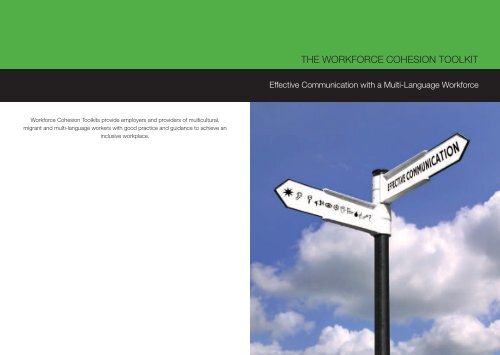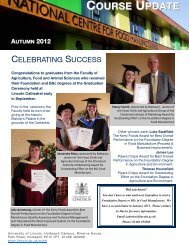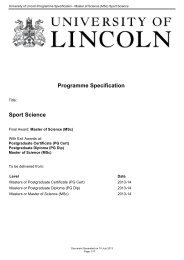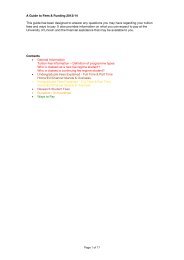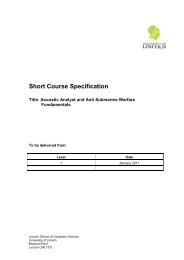Effective Communication with a Multi-Language Workforce
Effective Communication with a Multi-Language Workforce
Effective Communication with a Multi-Language Workforce
You also want an ePaper? Increase the reach of your titles
YUMPU automatically turns print PDFs into web optimized ePapers that Google loves.
ThE <strong>Workforce</strong> Cohesion Toolkit<br />
<strong>Effective</strong> <strong>Communication</strong> <strong>with</strong> a <strong>Multi</strong>-<strong>Language</strong> <strong>Workforce</strong><br />
<strong>Workforce</strong> Cohesion Toolkits provide employers and providers of multicultural,<br />
migrant and multi-language workers <strong>with</strong> good practice and guidance to achieve an<br />
inclusive workplace.
This<br />
<strong>Workforce</strong><br />
Cohesion<br />
Toolkit<br />
has been<br />
prepared by<br />
the following<br />
parties...<br />
W: www.labourproviders.org.uk<br />
W: www.co-operative.coop<br />
W: www.poultec.co.uk<br />
Authors<br />
Rachel Öner Ba (Hons), MFIL, QTLS;<br />
Ozan Erdinc Ba (Hons), MFIL;<br />
Pam Dowling AFIL.<br />
W: www.workforcecohesion.org<br />
Authors<br />
David Camp Fcipd;<br />
Stephen Mather<br />
Page 1<br />
Page 3<br />
Page 16<br />
Page 28<br />
Page 33<br />
Page 39<br />
Page 40<br />
Introduction<br />
Establishing effective internal<br />
<strong>Language</strong> and <strong>Communication</strong> Policies<br />
Features of <strong>Effective</strong> Workplace<br />
<strong>Communication</strong><br />
<strong>Language</strong> Levels and Developing Skills<br />
Checking for understanding<br />
Summary<br />
Appendices<br />
Contents<br />
Contributions to this publication have<br />
been gratefully received from Institute of<br />
Community Cohesion (iCoCo), Dunbia,<br />
Greencore Cakes (Hull), Hitchen Foods,<br />
Tulip, Speedibake and Vion Food Group Ltd.
<strong>Effective</strong> <strong>Communication</strong> <strong>with</strong> a <strong>Multi</strong>-<strong>Language</strong> <strong>Workforce</strong><br />
1. Introduction<br />
Why is it a challenge<br />
A complex picture<br />
Operational<br />
• Tasks<br />
• Peak Demands etc<br />
Purpose of this toolkit<br />
The purpose of this toolkit is to provide practical help and guidance to managers in<br />
the food industry on how to better communicate <strong>with</strong> a workforce where more than<br />
a single language is spoken (referred to throughout this toolkit as a multi-language<br />
workforce).<br />
Expectations<br />
• Behaviours<br />
• Standards<br />
Company<br />
• Mission<br />
• Values<br />
• Business Objectives<br />
Types of and reasons for communication<br />
Industry Standards<br />
• H&S<br />
• Hygiene<br />
• Product quality and safety issues<br />
Social<br />
The business need<br />
There is a clear business case for promoting effective communication <strong>with</strong>in the<br />
workplace. <strong>Effective</strong> communication leads to better performance, higher productivity<br />
and more staff buy-in. Engaging <strong>with</strong> staff and supporting their basic skills mean they<br />
feel valued and recognised and therefore generally do more to support the business.<br />
When assigning work tasks, establishing standards, providing health and safety<br />
information and in promoting the company’s internal values and culture, the business<br />
need for effective communication is obvious as are the consequences when it fails.<br />
Issues caused through problems in communication can lead to major incidents such<br />
as:<br />
• Serious and even fatal accidents.<br />
• Product quality and safety issues.<br />
• Legal cases being brought against employers for discrimination.<br />
• Tensions and conflicts in the workforce<br />
The potential gains of getting it right in terms of business margin and individual<br />
performance improvement are also highly significant so improved communications<br />
should be seen as an opportunity as well as a challenge.<br />
The challenge of effectively communicating across the entire workforce in every<br />
situation, in an environment where there may be limited English language skills and<br />
where a number of different languages are spoken is also obvious, but clearly does not<br />
reduce the critical need for it.<br />
How to use this toolkit<br />
This toolkit is intended to be an accessible source of practical information and help<br />
and is not intended to be a definitive guide to all aspects of communication in the<br />
workplace. Neither does it propose a “one size fits all” solution to the challenges of<br />
a multi-language workforce, but rather seeks to pull together knowledge, experience<br />
and examples of good practice from a wide variety of sources working in the industry,<br />
including producers, retailers, language experts and governmental bodies.<br />
The toolkit covers many of the main issues that arise in communicating <strong>with</strong> a multilanguage<br />
workforce and looks closely at the difficulties experienced by non-English<br />
speakers compared to the expectations held by their native speaking employer.<br />
Internal <strong>Communication</strong> and <strong>Language</strong> policies, as the means by which a company<br />
sets out to ensure fairness and non-discrimination and promote inclusivity at all times,<br />
are also discussed (section 2). In addition to providing practical hints and tips on<br />
the key features of effective communication, it gives help and advice on how cultural<br />
differences affect communication, and how to make communications more accessible<br />
to a migrant workforce (section 3).<br />
This toolkit also aims to provide an insight, through the use of short case studies, into the<br />
ways companies have successfully integrated the language needs of their workforce,<br />
giving practical examples of how communication issues have been addressed and<br />
how building a culture of inclusiveness has been effective. The toolkit will give hints<br />
and tips on the day-to-day support that can be given to people <strong>with</strong> English language<br />
needs. Looking at direct language issues in particular, topics will cover understanding<br />
language levels (section 4) and capabilities, translation and interpretation and how to<br />
check for understanding (section 5).<br />
1 2
<strong>Effective</strong> <strong>Communication</strong> <strong>with</strong> a <strong>Multi</strong>-<strong>Language</strong> <strong>Workforce</strong><br />
2. Establishing effective internal<br />
<strong>Language</strong> and <strong>Communication</strong> Policies<br />
Why have a <strong>Communication</strong> Policy<br />
Establishing and implementing written formal <strong>Communication</strong> and <strong>Language</strong> Policies<br />
promotes effective workforce communication, establishes good practice and limits the<br />
likelihood of breaching the Equality Act (see Appendix 1 for details of the Equality and<br />
Human Rights Commission web address where you can download codes of practice).<br />
It should also drive the processes and behaviours required in order to live up to the<br />
stated policy.<br />
A <strong>Communication</strong> and <strong>Language</strong> Policy should provide for communications between<br />
management and the workforce and between the different production areas of the<br />
workforce.<br />
What is a <strong>Communication</strong> Policy<br />
An overarching <strong>Communication</strong> Policy is to be recommended regardless of whether<br />
the organisation has a multi-language workforce and ensures a strategic approach<br />
to the what, when and how of two-way communications <strong>with</strong>in the workplace. Of<br />
course, such an overarching policy would take into account the language dynamics of<br />
the workforce and so would include a <strong>Language</strong> Policy and would reference strategic<br />
decisions that affect this such as recruitment policies and procedures.<br />
A <strong>Communication</strong> Policy would also need to consider the current situation as well<br />
as state intended goals. For example, current job requirements may stipulate that a<br />
minimum level of English is required upon recruitment but there may be a number of<br />
people in the business that do not currently speak English at that level but have been<br />
valued employees for many years. The policy, processes and procedures need to take<br />
this reality into account.<br />
The style of communication should also be considered– what skills and support are<br />
required by those doing or responsible for the communication In a multi-language<br />
environment the previous points would be considered in relation to, and appropriate<br />
for, the level of English spoken by those communicating.<br />
An excellent resource, when putting together an overarching <strong>Communication</strong>s Policy<br />
is the CIPD (The Chartered Institute of Personnel and Development) Practical Tool<br />
“Taking Employee <strong>Communication</strong> Seriously”, available through the CIPD website (See<br />
Appendix 1 for web address).<br />
Essentials – Example <strong>Communication</strong> and <strong>Language</strong> Policy Content<br />
1. Scope and Strategy<br />
2. Objectives<br />
3. Policy participants/signatories<br />
4. <strong>Language</strong> Policy<br />
a. Business language and spoken <strong>Language</strong> Policy<br />
b. Establishing the level of English required for each job at the site<br />
c. Recruitment advertising position<br />
e. <strong>Language</strong> and literacy testing policy and procedure<br />
i. Recruitment<br />
ii. Existing employees<br />
e. Translation policy<br />
f. Supporting workers whose first language is not English<br />
g. <strong>Language</strong> teams policy<br />
5. <strong>Communication</strong> channels<br />
Channel Purpose / Assessment of Frequency Measuring<br />
Objective Understanding<br />
<strong>Effective</strong>ness<br />
Intranet<br />
Email<br />
Meetings<br />
Training<br />
Notice boards/<br />
Posted Information<br />
Briefs / Verbal<br />
<strong>Communication</strong><br />
Written Information<br />
Staff Surveys<br />
Feedback Systems<br />
6. <strong>Communication</strong>, <strong>Language</strong> and Literacy Training Policy<br />
a. Managers’ communication competency standards<br />
b. ESOL (English for speakers of other languages) training policy<br />
c. Literacy training policy<br />
d. Assessment of understanding methods<br />
7. Policy review framework and timetable<br />
3<br />
4
Why have a <strong>Language</strong> Policy<br />
Historically many businesses haven’t established a <strong>Language</strong> Policy which has meant<br />
an unplanned situation where managers have to react to large numbers of workers<br />
<strong>with</strong> a variety of levels of English and deal <strong>with</strong> issues as best they can on an ad-hoc<br />
basis rather than plan, manage and put into practice a thought-through strategy.<br />
A <strong>Language</strong> Policy forms part of your overarching <strong>Communication</strong> Policy and enables<br />
plans to be made and processes to be put into place and rolled out to managers to<br />
ensure that business objectives, basic policies and procedures, required behaviours,<br />
standards and job tasks are understood by all workers, in order to maintain productivity,<br />
good industrial relations and high standards of health and safety. Therefore, having a<br />
<strong>Language</strong> Policy that works for you is vital.<br />
These questions should be considered in line <strong>with</strong> the following factors:<br />
<strong>Language</strong> Policy Considerations<br />
Employment, recruitment and non-discrimination law<br />
Skills availability<br />
Health and Safety requirements<br />
Job requirements<br />
<strong>Workforce</strong> cohesion<br />
<strong>Language</strong> Policy Questions<br />
A key consideration in developing your <strong>Language</strong> Policy is whether you currently have,<br />
or propose to have an English only policy for all communications in the workplace<br />
If Yes, this would mean that management instructions, health and safety literature,<br />
contracts, recruitment processes etc. will be delivered in English. The implications<br />
of this policy are that a minimum level of English would have to be determined for<br />
employees. This would be tested at recruitment and existing staff would be given<br />
support to meet this level.<br />
Section a) on page 7 explores the question of whether there should be a minimum<br />
standard of English in greater detail.<br />
If No, the implications will be that management instructions etc., as above, would<br />
have to be translated into as many different languages as are present in the workforce<br />
and the implications of this policy are that there is no minimum English language<br />
requirement for new or existing employees.<br />
Section b) on page 10 examines whether all or some written and verbal communication<br />
should be translated.<br />
5<br />
6
a) Recruiting for a required minimum level of English<br />
The decision about whether or not to require a minimum level of English for all workers<br />
(including agency staff) for each role in your business should form part of your <strong>Language</strong><br />
Policy. This will be informed by wider business and strategic considerations such as<br />
the availability of skilled labour <strong>with</strong> a minimum level of English, approach to sourcing<br />
labour and management style.<br />
The following box below identifies important legal considerations. If you choose a<br />
minimum required level of English you will also need to decide what that level should<br />
be. The box identifies important good practice to consider in order to avoid potentially<br />
directly or indirectly discriminating.<br />
Required Level of English – Good Practice<br />
• If you choose a minimum level of English requirement the site must establish that<br />
the English ability required from applicants, employees and agency workers is<br />
appropriate to the job being undertaken. The English language ability should be at<br />
a level necessary for the satisfactory and safe performance of the job and be able to<br />
be objectively justified for each individual job role.<br />
• The person specifications of all job roles in the company should include this<br />
appropriate English language ability level.<br />
• Candidates for employment (including native English speakers) should be tested<br />
during the recruitment process using an English language assessment test; there<br />
are commercially available Literacy and ESOL assessments and these should be<br />
used by suitably qualified people as the results are usually linked to the National Core<br />
Curriculum levels.<br />
• Where in-house English Literacy and <strong>Language</strong> selection tests are used, these<br />
should be well designed, reliable, properly administered and professionally validated.<br />
You may want to consult your local college or training provider to check that your<br />
test is fit for purpose.<br />
• It could be direct discrimination to target recruitment adverts to non-English speakers<br />
or indirect discrimination by disadvantaging people of particular non-UK nationalities<br />
or national origins if you were to ask all applicants to complete an application form<br />
in English or take a test which requires a higher standard of written English than the<br />
job itself requires.<br />
7<br />
English Only – Legal Matters<br />
• To require all conversations to be in English allows most British workers to<br />
communicate in their first language but prevents workers of other nationalities or<br />
national origins from doing so. Such a rule is likely to be indirect discrimination<br />
unless you can show that it has a legitimate aim and is a proportionate way of<br />
meeting that aim.<br />
• When the conversation is directly related to their work or to complying <strong>with</strong> health<br />
and safety standards, then it is likely to be proportionate for you to regulate the<br />
languages used but only so far as is necessary to ensure that everyone concerned<br />
understands what they and others must, or must not do.<br />
• When conversations take place during break time and are unrelated to work duties,<br />
an English-only rule is likely to be difficult to justify.<br />
• Where casual conversations take place during work time between operatives on a<br />
production line, you would need to consider whether there is any need to regulate<br />
the languages used. What would your aim be in imposing a potentially discriminatory<br />
English-only rule and would such a rule be a proportionate way of meeting that aim<br />
For example, if Latvian workers while working on a production line chat to each other<br />
in Latvian instead of English, do workers of other nationalities feel excluded If so, is<br />
there evidence that this affects their work performance If not then you may not be<br />
able to justify an English-only rule.<br />
You may also need to consider if there are to be exceptions included in this policy,<br />
for instance in the case of certain specialised roles where skills availability are low and<br />
how these exceptions will be managed in relation to the individuals needs and that of<br />
the business.<br />
The creation of whole teams or areas who speak a single language either as part of<br />
a policy or through common practice might appear as a way to deal <strong>with</strong> a multilanguage<br />
workplace but would leave the business open to legal challenge on the basis<br />
that such a practice would effectively amount to segregation of the workforce.<br />
8
<strong>Communication</strong> Channels<br />
Part of your overarching <strong>Communication</strong> Policy would include the methods used to<br />
communicate and would take into consideration your <strong>Language</strong> Policy.<br />
Methods may be broken down into:<br />
A. Structured Training<br />
B. Verbal <strong>Communication</strong><br />
C. Written <strong>Communication</strong><br />
D. Posted <strong>Communication</strong><br />
For each of these areas it is worth asking some questions about the methods you are<br />
using now or are intending to use in order to implement your policy <strong>with</strong>in the multilanguage<br />
environment you have, making sure that your chosen methods are effective<br />
and compliant.<br />
B. Verbal <strong>Communication</strong><br />
This includes induction, classroom based training, web-based and on the job task<br />
based training.<br />
Verbal <strong>Communication</strong> - Think about it...<br />
• Is the verbal communication understood by those to whom it is being communicated<br />
• For purposes of day-to-day management, line managers should be aware that it<br />
could be indirect discrimination to provide information or instructions in a language<br />
which excludes people of particular nationalities or national origins. It may be<br />
appropriate, for example, for a Polish line leader managing predominantly Polish<br />
workers to give instructions in Polish as well as in English, but they must still ensure<br />
that other workers who have a different main language are equally able to receive<br />
relevant instructions.<br />
A. Structured training<br />
This includes induction, classroom based training, web-based and on the job task<br />
based training.<br />
Training – Think about it<br />
• Can the training be sufficiently<br />
understood by all of those on the course<br />
• Are the language skills of the attendees<br />
sufficient to ensure learning takes place<br />
• Is the training developed and delivered<br />
in a way that is appropriate and<br />
understandable to those on the course<br />
• How do you measure the effectiveness<br />
of the training including those <strong>with</strong> limited<br />
English language skills<br />
Case Studies<br />
The importance of channels of communication is recognised by many of the companies<br />
interviewed. Tulip has regular ‘Joint Committee meetings’. The purpose of these is<br />
to give employees a vehicle to contribute to discussions or make suggestions for<br />
improvements. There are representatives of different language groups attending these<br />
committee meetings.<br />
Dunbia has TV screens in all of their main sites that display on a loop multi-language<br />
communications that covers information from their Employee Forums, company staff<br />
discounts and announcements reminding people of their “Speak out” helpline which is<br />
run by an independent company. Employees can speak to someone in a confidential<br />
manner in their own language, any queries are then sent to Dunbia Head Office to reply<br />
to and feedback is translated if necessary.<br />
Greencore Cakes (Hull) hold staff forums where workers from all nationality groups are<br />
represented and invited to share any concerns they may have. This, together <strong>with</strong> an<br />
‘open door’ policy, means that workers all feel included and have the confidence to<br />
contribute.<br />
9<br />
10
C. Written <strong>Communication</strong><br />
This includes contracts of employment, terms and conditions, staff handbooks,<br />
newsletters, company emails and letters.<br />
Written <strong>Communication</strong> - Think about it...<br />
• There could be challenges to whether contract terms are legally binding by employees<br />
of certain nationalities or national origins if they are not able to understand the terms<br />
and conditions stated in their standard contract of employment.<br />
• You may need to use more than one method to explain basic policies and procedures<br />
or the contents of employment contracts. For example you could provide a written<br />
translation of a whole document or main points into relevant languages, develop a<br />
simplified version <strong>with</strong> pictorial images to explain mutual obligations or use a ‘buddy’<br />
system pairing the new employee or agency worker <strong>with</strong> an experienced worker<br />
who speaks the same language and can be relied upon to translate the information<br />
accurately.<br />
• Disciplinary, grievance and complaints procedures should be fair and in a form<br />
and language accessible to all employees. You should take steps to ensure that<br />
employees <strong>with</strong> limited ability to read English understand fully what constitutes a<br />
disciplinary offence and the sanctions that can be imposed.<br />
D. Posted Information<br />
This includes safety notices, notice boards,<br />
performance boards etc.<br />
Posted Information - Think about it...<br />
There should be a process to ensure that the level of<br />
English used on all posted information is not higher<br />
than the level of English ability required of workers<br />
(see sections 4 and 5 for more information).<br />
How will you know<br />
Part of the <strong>Communication</strong> and <strong>Language</strong> Policy should include how you and other<br />
managers will know how effective your communication is, including when giving<br />
work instructions and when communicating company policies and standards. Some<br />
suggestions about how to do this can be found in Section 5.<br />
Case Study<br />
Greencore Cakes (Hull) encourages the use of English throughout the company. This<br />
starts at recruitment when workers sit an English assessment. The results of these<br />
assessments have proven to be very effective and give a score for role suitability;<br />
those <strong>with</strong> higher levels can then be considered for higher roles. This, in turn, is a<br />
good motivation to learn English for anyone wanting to progress in the company. For<br />
workers who are not as advanced in English, ESOL classes are held twice a week<br />
on site and workers, permanent or agency, can join these classes from day one. All<br />
classes are funded by Greencore and are scheduled on different work patterns.<br />
Having a minimum standard of English has been effective for the company. Signage<br />
and written documentation is all in English, saving costs on translations. Inductions<br />
and training sessions are held in English and only if there is a real need to translate, is<br />
an interpreter is provided. The company regularly asks workers to repeat back what<br />
they have been instructed. One way this is achieved is through regular audits on the<br />
shop floor by personnel working <strong>with</strong>in the offices which includes conversations <strong>with</strong><br />
workers regarding the role they are carrying out, health and safety, and risks. Also,<br />
workers that are transferred to another role <strong>with</strong>in the business, have to be able to fully<br />
demonstrate physically and verbally that they understand their new tasks before they<br />
can be signed off to do the job.<br />
11<br />
12
Internal <strong>Communication</strong> Procedures<br />
Establishing and identifying internal communication procedures requires looking at<br />
how you presently communicate <strong>with</strong> your workforce. The table below can be used<br />
as a guide for things you need to consider in formulating the internal communication<br />
procedures that are right for your business.<br />
Channel Purpose Intended Result Frequency<br />
Intranet<br />
Home Page<br />
Department Page<br />
Shop Floor Screens<br />
Email<br />
Information Bulletins.<br />
Director’s messages.<br />
Company Information.<br />
Department summary<br />
reports<br />
Company profile and<br />
key business metrics<br />
Current orders and<br />
output targets<br />
Output KPIs and<br />
performance data<br />
Passing information<br />
one way.<br />
Passing information<br />
one way.<br />
To keep employees up<br />
to date on business<br />
progress.<br />
To keep department<br />
staff up to date<br />
Tracking of output and<br />
motivation of teams.<br />
Aid to engagement -<br />
employees understand<br />
progress and issues.<br />
Employees understand<br />
what the rest of the<br />
organisation is doing.<br />
Daily<br />
Daily<br />
Daily<br />
Weekly and as<br />
necessary.<br />
Monthly<br />
Channel Purpose Intended Result Frequency<br />
Meetings<br />
Informal lunches <strong>with</strong><br />
senior managers<br />
Director’s briefings and<br />
presentations<br />
Line Managers and<br />
supervisors meetings<br />
Supervisor’s team<br />
meetings<br />
Common interest<br />
group meetings<br />
Training<br />
Health and Safety<br />
Training, refreshers and<br />
updates<br />
Food Hygiene<br />
Noticeboards<br />
Notification of common<br />
interest group<br />
meetings<br />
News, output charts,<br />
rosters, work planning<br />
etc.<br />
Two way<br />
communication <strong>with</strong><br />
line managers and<br />
supervisors.<br />
Two way<br />
communication <strong>with</strong> all<br />
employees<br />
Operational briefings<br />
Operational briefings,<br />
work instructions.<br />
Cross cultural<br />
communication and<br />
the development of an<br />
inclusive workforce.<br />
Safe working practices.<br />
Understanding to be<br />
tested by ‘teach back’<br />
techniques.<br />
Safe working practices.<br />
Understanding to be<br />
tested by ‘teach back’<br />
techniques.<br />
Cross cultural<br />
communication and<br />
the development of an<br />
inclusive workforce.<br />
Simple straightforward<br />
notices conveying<br />
information.<br />
Discussion on big<br />
issues and upward<br />
feedback on shop floor<br />
issues.<br />
Presentation of<br />
strategic issues<br />
Managers understand<br />
what others are doing.<br />
Employee knowledge<br />
of output targets and<br />
order status<br />
Greater knowledge of<br />
co-workers<br />
Continued safe<br />
working at all levels.<br />
Continued production<br />
of safe products<br />
Greater knowledge of<br />
co-workers<br />
Better informed and<br />
engaged employees.<br />
Twice a month<br />
Three times a year.<br />
Every other week.<br />
Daily<br />
Monthly as required.<br />
In accordance <strong>with</strong> the<br />
Company’s Health and<br />
Safety Policy.<br />
In accordance <strong>with</strong><br />
the Company’s Food<br />
Hygiene policies.<br />
Monthly/updated as<br />
required.<br />
Weekly<br />
Surveys<br />
Employee Survey<br />
(Permanent,<br />
temporary and agency<br />
employees)<br />
To gain a measure of<br />
employee satisfaction<br />
and determine<br />
issues for continuous<br />
improvement.<br />
Formal record of the<br />
employee voice.<br />
Once a year.<br />
13 14
<strong>Effective</strong> <strong>Communication</strong> <strong>with</strong> a <strong>Multi</strong>-<strong>Language</strong> <strong>Workforce</strong><br />
Implementation Processes<br />
The following box identifies factors to consider in developing and implementing written<br />
<strong>Communication</strong>s and <strong>Language</strong> Policies:<br />
Implementation Tips<br />
How will workers and worker<br />
representatives be involved in<br />
developing and implementing the<br />
Policy<br />
You could have a Focus Group to discuss<br />
content, making sure all relevant groups<br />
are represented.<br />
Will it be a jointly agreed process <strong>with</strong><br />
worker representatives and Trade<br />
Unions where present<br />
The Focus Group could report back as a<br />
regular agenda item.<br />
What are worker Learning / Safety<br />
Representatives’ roles in ensuring<br />
that workers <strong>with</strong> limited English<br />
skills are effectively communicated<br />
<strong>with</strong><br />
You should make sure that those<br />
representatives have the skills and<br />
understanding to carry out this role.<br />
What training will be provided to<br />
line managers to communicate in<br />
accordance <strong>with</strong> the policy<br />
Provide training for managers and<br />
supervisors in Cultural Awareness as well<br />
as <strong>Language</strong> Awareness.<br />
How will it be ascertained that<br />
workers find the information<br />
comprehensible and understand the<br />
message being communicated<br />
Consult a language specialist for advice<br />
if needed.<br />
What feedback loops for workers will<br />
be provided to enable the upward<br />
flow of information<br />
Involve learning representatives in all<br />
stages of the process.<br />
How will the effectiveness of<br />
individual manager’s communication<br />
skills be measured<br />
This could be part of your Annual<br />
Performance and Appraisal System.<br />
How and when will the policy be<br />
reviewed<br />
Schedule regular review dates. Your<br />
communication and <strong>Language</strong> Policy<br />
may need to be adapted considerably<br />
while it is being implemented for the first<br />
time.<br />
3. Features of <strong>Effective</strong> Workplace<br />
<strong>Communication</strong><br />
There are some clear features of effective communication to use whoever your audience<br />
is whether you are communicating <strong>with</strong> an English speaker or a non-English speaker.<br />
<strong>Communication</strong> Essentials<br />
• Make it clear<br />
• Keep it concise<br />
Is the information clear<br />
• Make it accessible<br />
• Check it has been understood<br />
All the information provided, written or verbal, should be neutral, free from bias and<br />
uncomplicated. You should:<br />
• Re-word documents so that they include words used more frequently rather than<br />
their formal equivalents such as use of ‘buy’ instead of ‘purchase’.<br />
• Arrange regular feedback sessions <strong>with</strong> your employees to gather suggestions on<br />
how to improve communication.<br />
• Make sure your communications suit your audience. Whether you are talking or<br />
presenting written information.<br />
• Summarise the discussion at the end. A good communicator realises that clarity<br />
now will save time and prevent misunderstandings later. Summarising also reassures<br />
the audience that you have also been listening and understood any comments and<br />
feedback that they have made.<br />
• Do not be aggressive in your manner. Make sure your tone is suitable for the<br />
audience and be assertive.<br />
• Think about the speed of your speech and whether rushing your message will mean<br />
the listener misses out on vital information.<br />
15<br />
16
Is it concise<br />
Be concise <strong>with</strong> the information you provide. Remember it takes time to develop,<br />
prepare, distribute, read, listen and understand information and time is money. More<br />
complex language can often result in misunderstandings and can be counterproductive.<br />
You can still be polite and direct <strong>with</strong> the information you give and you can achieve<br />
this by:<br />
• Identifying the key points, ideas and in some cases just key words that you want to<br />
convey in each bit of communication and recognise that the rest is not necessary.<br />
• You should not be abrupt, but succinct and direct. Do not hide the main message of<br />
what you want to say in endless waffle.<br />
Is it accessible<br />
Giving clear and concise information is not enough unless it is also accessible. Some<br />
questions to consider are:<br />
• Do you have the means to establish which language a person speaks You could<br />
use a <strong>Language</strong> Identification card. These are used extensively in the public sector.<br />
(See Appendix 1).<br />
• Do you have an interpreting service available for when needed (See Appendix 1)<br />
• Are you going to translate documents The Association of Labour Providers provides<br />
a low cost translation service. (See Appendix 1)<br />
• Do you have bi-lingual dictionaries that can be used to explain simple instructions<br />
• Have you considered transferring information to pictorial images<br />
• Have you considered providing on site ESOL classes (for definition and information<br />
on ESOL levels see section 4).<br />
Has it been understood correctly<br />
The above steps of providing clear, concise and accessible information will really only<br />
be fully effective if you follow through by checking someone has understood. This final<br />
stage could be seen as a Critical Control Point (CCP).<br />
Neither side should be afraid to ask questions if they do not understand or need further<br />
details about what is being said. Remember that a conversation should be interactive<br />
and not a one-way dialogue. For additional guidance on checking for understanding<br />
see section 5 of this Toolkit.<br />
It may also be valuable to give workers an open channel for feedback, which can help<br />
to understand how the communication has been received; worker committees <strong>with</strong><br />
regular meetings can be organised, or make it clear to all that an open door policy<br />
exists.<br />
Conducting <strong>Effective</strong> Staff Surveys<br />
Well managed staff surveys can assist in increasing workforce cohesion and morale;<br />
resulting in increased staff retention rates, lowered absenteeism, improved productivity,<br />
and increased profitability. There are various actions you can put in place to ensure the<br />
success of your staff survey. These include:<br />
1. Agree the aims and objectives of the survey - talk to managers and workers in focus<br />
groups or individually to decide what the purpose of the survey is, why the organisation<br />
is conducting it, where and when workers will be able to access it and how the results<br />
will be used.<br />
2. Market the survey - create awareness in the workplace; workers need to be given<br />
plenty of notice about an upcoming survey. Use any medium(s) available such as<br />
notice boards or meetings. Emphasise the importance of workers responding and<br />
how valuable their opinion is to ensure necessary improvements can be made to the<br />
organisation; be clear about the processes you have in place to review survey findings<br />
and action results.<br />
3. Guarantee employee confidentiality – reassure workers that their responses will<br />
not be linked to them as individuals. This will ensure that workers give a more honest<br />
response and lead to more valuable feedback.<br />
17<br />
18
4. Make your survey accessible – ensure that your workers understand and can access<br />
the survey. Use simple and direct language, and translate the surveys into required<br />
languages when possible. Consider workers <strong>with</strong> poor literacy levels; use a survey<br />
tool which offers the option of issuing the survey by phone for those workers who<br />
cannot read the survey questions.<br />
5. Consider incentives for completed responses <strong>with</strong>in the given timeframe – research<br />
shows incentives increase response rates. They are especially useful in a longer<br />
survey and can be anything that will appeal to the employee demographic.<br />
6. Send reminders - survey reminders can increase your responses by another 10-<br />
15% by providing an additional prompt to workers to complete the survey 7-10<br />
days after the initial invite was sent.<br />
7. Share results - communicate a summary of the key findings <strong>with</strong> your workers<br />
promptly after survey completion. This will provide assurance that time and effort<br />
spent on completing the survey was worthwhile. Furthermore, transparency will<br />
promote worker inclusion, and reinforce loyalty and trust in the organisation.<br />
8. Take action on findings - it is imperative that the organisation is committed to making<br />
appropriate changes for improvement based on the findings of the survey. If no<br />
action is taken (or seen to be taken), the survey could potentially have an adverse<br />
effect <strong>with</strong>in the organisation, promoting distrust and often reinforcing some of the<br />
concerns raised in the workers feedback.<br />
Good <strong>Communication</strong> - Practice, Tips and Techniques in <strong>Multi</strong>-<strong>Language</strong><br />
<strong>Workforce</strong><br />
Employees in a fast paced manufacturing environment need to process a lot of<br />
information in the course of their jobs and this information can range from receiving<br />
simple instructions to listening to a technical demonstration. Where those involved in<br />
the communication speak different first languages, in order to make sure that such<br />
communication is effective, here is some practical advice, tips and techniques for<br />
being understood.<br />
Verbal <strong>Communication</strong><br />
Three golden rules should apply when communicating <strong>with</strong> non-English speaking<br />
nationals.<br />
Golden Rules<br />
The Three Golden Rules of Verbal <strong>Communication</strong><br />
1. Don’t raise your voice. Shouting can actually make understanding harder, whereas it<br />
is easier to be understood if you are calm and encouraging in your speech. The listener<br />
should not feel embarrassed by not understanding and if they feel at ease, they are<br />
more likely to follow and take part in any conversation.<br />
2. Speak slowly. One of the most effective ways to be understood is to use a much<br />
slower pace than you would usually do. This allows for the recipient to process the<br />
information.<br />
3. Keep your sentences short and to the point. Someone who is unable to speak<br />
English well will be more likely to understand short, clear and simple sentences than<br />
long, complex ones which are hard to follow.<br />
There are however, several other techniques you can use in addition to the three<br />
Golden Rules.<br />
• Pause in between points.<br />
• Actively encourage the worker to ask questions and let you know if they do not<br />
understand.<br />
• Check for understanding (see section 5) after every point made. Ask open questions<br />
such as “So which colour knife do you need to use for raw meat’ as opposed to<br />
‘Do you understand’.<br />
• A practical demonstration <strong>with</strong> the use of mime or gestures can cross many<br />
communication barriers and aid understanding of a difficult topic - beware, though,<br />
that cultural differences can affect intentions here.<br />
• Make sure the words you use can be understood and are not too difficult, avoiding<br />
technical language and jargon.<br />
19<br />
20
Keeping it Simple<br />
Below is a list of example words that can be very difficult to understand. Opposite<br />
these is a suggestion of a more simplified word that can be used:<br />
Advise<br />
Belongings<br />
Commence<br />
In the event of<br />
Issue you <strong>with</strong><br />
On receipt<br />
On request<br />
Per annum<br />
Prior to<br />
Purchase<br />
Regarding<br />
Request<br />
Should you wish<br />
Terminate<br />
tell<br />
things<br />
start<br />
if<br />
give you<br />
when you get<br />
when you ask<br />
a year<br />
before<br />
buy<br />
about<br />
ask for<br />
if you want<br />
end<br />
Optimising the chances of being understood<br />
• Be prepared to repeat yourself if you are not understood. Firstly, repeat what you<br />
have said then re-phrase if you are still not understood.<br />
• Avoid using irony or jokes. Phrases such as “I wasn’t born yesterday” can be very<br />
confusing.<br />
• Use ‘active’ language such as ‘You must wear a hair net’ rather than ‘Hair nets must<br />
be worn’ – in the second example it is not clear who should carry out the action.<br />
• ‘Buddy’ systems can work very effectively. Wherever possible, pair a new employee<br />
up <strong>with</strong> a more experienced worker who can act as a mentor. The ‘buddy’ could be<br />
a compatriot or otherwise, but someone who has a more advanced level of English.<br />
• For final consolidation, always give a hand-out of the main points that were made in<br />
the discussions; however, make sure anything written down is also in ‘plain English’.<br />
Written English<br />
Much care needs to be taken <strong>with</strong> the use of written English in any document given to<br />
a migrant worker. In fact, the skill of reading can be harder for some, especially those<br />
who have not received any formal language training in the past. Therefore, the same<br />
rules as for spoken instructions apply. The table on page 23 identifies some of the<br />
techniques you can use to make written communication more effective.<br />
There are many more examples of how to simplify language and these can be<br />
downloaded from the Plain English Website (www.plainenglish.co.uk).<br />
If you do need to use jargon or technical language relating to a particular job, make<br />
sure you have explained it first. You may wish to consider having a ‘vocabulary’ list<br />
of words that are specific to your industry or their job role – this way they have the<br />
opportunity to research the words by checking <strong>with</strong> a colleague or looking the word<br />
up. This list can be given out at induction or any training event or update meetings.<br />
Written English<br />
21<br />
22
Process<br />
Sentences<br />
Bullet points<br />
Vocabulary<br />
Familiar words<br />
No capitals<br />
Active* not passive language<br />
Instructions in order<br />
Be concise<br />
Images<br />
Toolbox Talk Handouts<br />
Allow time<br />
Reason or effect<br />
Keep them short!<br />
Use bullet points to clearly separate key pieces of information.<br />
Avoid vocabulary that is too formal or difficult to understand.Use<br />
simpler, more recognisable word<br />
Use words that will be heard on a regular basis, (making sure<br />
these are either explained beforehand or as a footnote to the<br />
text).<br />
Use lower case print – it is recognised that capital letters are<br />
generally more difficult to read. Capitals are also recognised by<br />
many cultures as having the effect of shouting<br />
Make sure that you use active verbs as well as simpler language<br />
– “you will be observed” can easily be changed to “He will watch<br />
you”.<br />
It may seem obvious, but make sure instructions are written in<br />
the correct order, preferably <strong>with</strong>out using time-markers such as<br />
‘before that’, ‘afterwards’ or ‘meanwhile’, but <strong>with</strong> numbers in<br />
sequence.<br />
If your document is large, consider shortening it and only giving<br />
out the specific information that applies to the worker<br />
Use images and photos wherever<br />
possible to help get the message<br />
across – however, beware of culturally<br />
sensitive photos (possibly religious) or<br />
those that are very specific to our<br />
culture (a lollipop lady <strong>with</strong> her stop sign).<br />
Easily recognisable images are the<br />
quickest way to get a message across,<br />
which is why they are used widely in<br />
Health and Safety signage.<br />
* Source: ESOL for Food Manufacturing booklet, National Skills<br />
Academy for Food & Drink Manufacturing and Poultec Training.<br />
Toolbox Talks are used widely and follow many of these<br />
principles mentioned. Whilst these talks are good for getting a<br />
message about a procedure or law across succinctly, be aware<br />
that some of the language in these talks may still be beyond the<br />
general comprehension of many ESOL workers. You may wish to<br />
go through the Talk first and simplify any difficult language or add<br />
a key explaining vocabulary at the bottom of the page<br />
When giving out forms, give plenty of time for them to be filled in.<br />
Some learners from Arabic or Chinese speaking countries will struggle <strong>with</strong> everything<br />
from simple signage to manuals as they are adapting to a new script, having not been<br />
brought up using the Roman alphabet or reading from left to right. Writing in a new<br />
script is difficult and can make a person’s writing look scruffy or childish. It is easy then<br />
to make incorrect assumptions on a person’s educational background by the quality<br />
of their written language.<br />
Case Study<br />
Speedibake created a cartoon baker character called PePE to help employees in their<br />
factories recognise the correct type and specification of Personal Protective Equipment<br />
(PPE), hence the name PePE, that is needed in any specific area.<br />
* Verbs are active when the subject of the sentence does the action. Verbs are not active when the subject of the<br />
sentence has the action done to it.<br />
23<br />
24
Potential Cultural Misunderstanding<br />
With over 13 different languages being spoken, translations did not always fully<br />
explain the exact type of PPE required and their internal audit programme identified<br />
non conformances in the PPE section, for example; some operatives using a general<br />
purpose glove when handling hot trays that really required a glove <strong>with</strong> a greater level<br />
of protection. They therefore felt there was a need to develop an understandable tool<br />
to protect their multicultural, multi-language workforce from injury and to keep them<br />
safe.<br />
To implement PePE into Speedibake, there was clear communication to ensure that<br />
all employees were aware of the changes, risk assessments were carried out and all<br />
departments had input and responsibility so that it was not just the function of the<br />
health and safety department.<br />
By using a set of standard cartoon style PPE drawings - linked to a standard PPE<br />
specification sheet, signage can be created to show the particular hazards in any area<br />
or for any task and the PPE required <strong>with</strong>out the need for text. Simply click on the item<br />
of PPE, then copy and paste it onto the PePE character.<br />
Speedibake’s theory is that if you need to know what PPE is required in any area, just<br />
look for PePE! The development and production of the PePE character and all the<br />
associated tools and scenes has only cost Speedibake around £1000.<br />
PePE was introduced into the Speedibake sites in the summer of 2011 as part of<br />
their “Safety First” program which over the years has had phenomenal success <strong>with</strong><br />
incidents dropping from 151 five years ago, to just 17 in the last business year.<br />
Speedibake was awarded a top prize at the Institution of Occupational Safety and<br />
Health (IOSH) for their PePE cartoon character.<br />
Dealing <strong>with</strong> Cultural Differences<br />
Cultural differences can have a big impact on communication, whether written or<br />
spoken. With regards to speaking, some cultures raise their voices as a sign of being<br />
more assertive. Other cultures however speak much more softly. Even <strong>with</strong> the best<br />
will in the world, miscommunication is likely to happen, especially when there are<br />
significant cultural differences between people. There are some preventative methods<br />
to bear in mind:<br />
• Be neutral when speaking - when talking to various nationalities it pays to be more<br />
neutral <strong>with</strong> the tone and volume you use.<br />
• Be considerate of other people’s input into the conversation. Many cultures will not<br />
interrupt, but wait their turn. Some cultures do interrupt and it is not considered rude,<br />
so be tolerant of this.<br />
• Don’t touch - patting a head may be considered to be a friendly or affectionate gesture<br />
in our culture, it is considered inappropriate by many Asians to touch someone on<br />
the head, which is believed to be a sacred part of the body. In the Middle East, the<br />
left hand is reserved for bodily hygiene and should not be used to touch another<br />
person or transfer objects. In Muslim cultures, touch between opposite sexes is<br />
generally inappropriate.<br />
• Use eye contact wisely – we may think that good eye contact is a demonstration of<br />
attentiveness. In many cultures; however, including Asian and middle Eastern, eye<br />
contact can be rude, especially between opposite sexes.<br />
• Be aware of gestures – hand gestures may have a different meaning and/or be<br />
offensive to those from other cultures. One common example is the use of a finger or<br />
hand to indicate “come here please”. This gesture in some cultures is very offensive.<br />
Pointing is also considered to be rude in some cultures and Asians typically use their<br />
entire hand to point to something.<br />
Be aware of gestures<br />
hand gestures may have<br />
a different meaning and/<br />
or be offensive to those<br />
from other cultures.<br />
25<br />
26
<strong>Effective</strong> <strong>Communication</strong> <strong>with</strong> a <strong>Multi</strong>-<strong>Language</strong> <strong>Workforce</strong><br />
Case Study.<br />
A lack of cultural understanding can have an effect on working relationships. A team<br />
leader at Greencore Cakes (Hull) wondered why workers were disappearing from the<br />
production lines at the same time each morning. A potential conflict was avoided after<br />
a quick look at a religious calendar informed HR that their workers were probably<br />
going off to pray. When questioned, the workers were so pleased that the employer<br />
had taken the trouble to look this up. The company now has a dedicated prayer room<br />
and workers have agreed <strong>with</strong> their supervisors to stagger the timings that they go to<br />
prayer to ensure that there are always enough staff on the shop floor.<br />
Tulip also has an outside consultant delivering regular training to every manager and<br />
supervisor on ‘Dignity at Work’. The sessions cover topics such as how to speak<br />
to people appropriately and cultural and religious awareness. They are currently<br />
developing an in-house training programme to reach all employees.<br />
To communicate effectively, you need to be aware of many different factors and the<br />
information given is not an exhaustive list of good practice. There are many other<br />
features to take into consideration, such as how culture and educational background<br />
can have an effect on communications. Your main aim should be to make your working<br />
environment as inclusive as possible and to engage <strong>with</strong> all your staff using the most<br />
appropriate methods to make sure communications are understood.<br />
One idea is to have a representative; a member of the training or HR team could be<br />
nominated for liaison or advise on matters concerning the communication and training<br />
of staff who speak English as another language. This member of staff could have<br />
received some basic awareness training or be able to use support documents that are<br />
available for employers.<br />
4. <strong>Language</strong> Levels and<br />
Developing Skills<br />
Why is it important to understand <strong>Language</strong> Levels<br />
We cannot expect for everybody in the workforce to have the same level of English.<br />
Workers’ backgrounds may vary considerably. Some may have achieved high<br />
qualifications in their countries and speak several languages, therefore they already<br />
have better study skills and can pick up a language more easily. Some may have<br />
received very little or no formal education in their countries and maybe cannot read<br />
and write in their own language. Others may have a good understanding of the written<br />
language from previous self-study, but find it hard to speak English, while others have<br />
lived in England for a while and speak relatively well but have never attended language<br />
classes to improve their skills and find the written word difficult.<br />
In addition there are numerous reasons why workers who are not native speakers may<br />
find it difficult to understand conversations in English:<br />
• They may be in a formal interview or discussion which most people find stressful in<br />
some way, in addition to having to perform in a second or third language.<br />
• People often do not like to admit that they cannot understand.<br />
• They may not be familiar <strong>with</strong> an accent.<br />
• The conversation may be taking place in a noisy environment.<br />
• If there are other people in the room who speak the same language they can be a<br />
tendency to over rely on translation from a colleague, especially if there are friends/<br />
partners who they perceive to speak better English. In addition to this, some people<br />
feel embarrassed to speak in a foreign language in front of their peers/partners,<br />
especially if they come from a culture of mocking people who make mistakes.<br />
If you have a minimum language requirement, then the information must be presented<br />
in a way that could be understood by all. This means that you need to make sure that<br />
all your communication is not above this minimum level of language. You may need<br />
to get assistance from your ESOL provider <strong>with</strong> setting and checking language levels<br />
ESOL stands for English for Speakers of Other <strong>Language</strong>s and is a set of courses<br />
designed for people whose main language is not English.<br />
27<br />
28
Experience shows that many manufacturing companies in the UK have a high<br />
proportion of workers <strong>with</strong> ESOL needs. Anyone <strong>with</strong> ESOL training requirements<br />
could have needs in any of the four main skills:<br />
• Speaking<br />
• Listening<br />
• Reading<br />
• Writing<br />
ESOL is divided into six levels:<br />
ESOL<br />
Pre-entry A total beginner level <strong>with</strong> no exam outcome<br />
Entry 1 Equivalent to Key Stage 1<br />
Entry 2 Equivalent to Key Stage 1<br />
Entry 3 Equivalent to Key Stage 1<br />
Level 1 Equivalent to NVQ Level 1 / GCSE grades G-D / Key Stage 2<br />
Level 2 Equivalent to NVQ Level 2 / GCSE grades C - A* / Key Stage 3/4<br />
It is important to understand what the abilities of workers are at different ESOL levels.<br />
See Appendix 2 to get an idea about the capabilities of ESOL learners carrying out<br />
a common speaking task in the workplace, that of discussing absences from work.<br />
ESOL levels in the workplace<br />
Based on the levels of learners enrolled on workplace ESOL courses, the majority of<br />
migrant workers in the manufacturing sectors in England are Entry 1 to Entry 2 levels;<br />
a level which could be described as not fully competent in basic English at work.<br />
Entry 3 is the level learners should aim to reach in order to meaningfully cope <strong>with</strong><br />
day-to-day language of work, procedures and understanding instructions and<br />
generally getting on better <strong>with</strong> colleagues. Furthermore, it is a good platform<br />
for progression, going on to study other vocational workplace courses such as<br />
NVQs (National Vocational Qualifications) and Apprenticeships or CIEH certified<br />
industry qualifications.<br />
The last two levels on the scale are Level 1 and Level 2, Level 2 being the equivalent to<br />
grades C-A* at GCSE. Levels 1 or 2 would be appropriate levels for Supervisors and<br />
Managers to function competently, <strong>with</strong> paperwork and instructions in mind.<br />
Understanding possible effects of language difficulties on worker behaviour<br />
In order to be able to include workers effectively, it is desirable to have some<br />
understanding of the difficulties faced by ESOL learners.<br />
Shifting Perspective<br />
Imagine the scenario. You may have an experienced employee who evades attending<br />
training sessions or has a negative attitude towards reading a form or manual. This<br />
employee, whether their main language is English or not may have communication<br />
issues or difficulties in reading or writing or maybe cannot read or write at all. Once<br />
this fact is revealed their behaviour begins to make sense and steps can be taken to<br />
support and possibly develop this person’s skills.<br />
For many migrant workers whose main language is not English, these difficulties<br />
are there from the beginning of starting their job. An ability to effectively show their<br />
capabilities in any role can be hindered by their lack of ability to express themselves<br />
in English.<br />
Vocabulary and “false friends”<br />
Common areas of difficulty in English for workers for whom English is not their first<br />
language are not simply matters of grammar. Vocabulary can also be an issue. Clearly<br />
someone still learning a language has a limited number of words to use to make<br />
themselves understood and the likelihood is that they will not understand some of<br />
the words a native speaker is saying to them. In addition to a restricted vocabulary<br />
some words in one language can look very similar to a word in English, but can mean<br />
a different thing. These are called ‘false friends’. We are all aware of the example<br />
‘pants’ in American English means ‘trousers’ in British English. Some examples from<br />
languages we now frequently hear in the UK are:<br />
29<br />
30
False Friends<br />
• Fabryka (Polish)<br />
• Hazard (Polish)<br />
• Agenda (Polish)<br />
• Agenda (Portuguese)<br />
• Avisar (Portuguese)<br />
• Injúria (Portuguese)<br />
• Real(Portuguese)<br />
• Caution (French)<br />
• Eventuálne (Czech)<br />
• Dislokacija (Lithuanian)<br />
factory (English), not ‘fabric’<br />
gambling (English), not ‘hazard’<br />
department, branch (English), not ‘agenda’<br />
diary (English), not to be used for ‘meeting<br />
agenda’<br />
warn (English), not ‘advise’<br />
insult (English), not ‘injury’<br />
royal (English), not ‘real’<br />
deposit, security or bail (English), ‘not<br />
caution’<br />
possibly (English), not ‘eventually’<br />
location (English), not ‘dislocate’<br />
The use of slang and colloquialisms<br />
Expressions and idioms can be particularly difficult for a worker <strong>with</strong> limited English<br />
to understand. Trying to understand colloquial expressions (i.e. phrases common<br />
in everyday language rather than in formal speech) can be very hard, especially as<br />
English speakers very often use them as they sound friendly. An example would be<br />
“This is Arturas; he will show you the ropes rather than you fathoming it out”. The ESOL<br />
learner will automatically start translating this saying literally and come to an abrupt halt<br />
when faced <strong>with</strong> the word ‘fathoming’!<br />
Developing skills through ESOL training<br />
ESOL training can aid staff retention and development if they can see a path of<br />
progression <strong>with</strong>in the company. Most learners state at the end of ESOL courses in the<br />
workplace that they can see a benefit in their work such as being able to communicate<br />
better <strong>with</strong> their supervisor.<br />
There are training providers who can deliver courses in the workplace directly, fitting<br />
around shift patterns. Some of the best types of course you can offer your staff<br />
are those that have been contextualised to the industry or job the employees are<br />
working in.<br />
If you are unable to find a provider in your area, you could contact your local Skills<br />
Funding Agency. Alternatively, the National Sector Skills Councils have details of<br />
Training Providers affiliated <strong>with</strong> their sectors (See Appendix 1).<br />
Case Study<br />
Try to build links <strong>with</strong> a local training provider or college which can provide ESOL<br />
classes. The Tulip Redruth site at Cornwall is one company that established ties <strong>with</strong><br />
their local college and regularly has two teachers on site delivering ESOL. The training<br />
is free to workers and available to them <strong>with</strong>in their work day. Training is available for<br />
two hours and employees are offered to finish their shift one hour early (paid) to attend.<br />
The training has been very successful <strong>with</strong> an excellent pass rate.<br />
Colloquialisms<br />
• “He will show you the ropes rather than you fathoming it out”<br />
• “You mustn’t use that machine till you have had the training. It is best to be on the<br />
safe side”<br />
• “There’s safety in numbers”<br />
• “Come on; time is money”<br />
31<br />
32
<strong>Effective</strong> <strong>Communication</strong> <strong>with</strong> a <strong>Multi</strong>-<strong>Language</strong> <strong>Workforce</strong><br />
5. Checking for Understanding<br />
Lesson from example 1<br />
Whether or not workers have understood communication is forefront on many<br />
employers’ minds. A common comment is “How do you know spoken communication<br />
has been understood” “How do you know things have been translated or interpreted<br />
the way you wanted them to be”*<br />
*Typical comments raised by HR Managers of major food manufacturing companies<br />
consulted.<br />
Checking for understanding is a trademark of good communicators. Non-native<br />
speakers of English can operate at differing levels in each aspect of language, namely<br />
speaking, listening, reading and writing. Therefore, it is important to establish and<br />
know what skills they are good at, initially, in order to convey information and then to<br />
check for understanding afterwards.<br />
It is important to check the understanding of employees <strong>with</strong> ESOL needs regardless<br />
of how simple the information is. However, it is also important to remember that not<br />
understanding simple information is not due to a lack of intelligence but to a lack of<br />
language skills, which can be developed in time.<br />
What follows are three examples where misunderstanding has occurred. For each of<br />
these examples there are some important lessons that can be taken from the situation<br />
and how to avoid them happening in your business.<br />
When Misunderstandings Occur - Example 1<br />
Karwan is from Iraq and came here 10 years ago when he was 19. He has had no<br />
previous education either here or in his country. He is very talkative, confident and<br />
friendly. He is fluent in English and when he speaks it is not initially obvious that English<br />
is not his first language.<br />
He got offered a job after his successful interview and was asked to read and sign<br />
things during his induction to confirm that he understood. He did so as he didn’t want<br />
to lose his job. It later became clear that Karwan could hardly read and write. Therefore<br />
he was not able to follow the written instructions, although he was good at his job and<br />
a quick learner if somebody explained verbally what he had to do.<br />
What lessons can we learn from this<br />
• There should have been a formal or informal needs assessment after the interview<br />
to establish his level of reading, writing, listening and speaking skills. This could have<br />
been used to decide how to convey information.<br />
• Never assume full understanding <strong>with</strong>out checking for it using appropriate methods.<br />
Written material could have been read out for him to repeat/retell the information<br />
or demonstrate it to confirm his understanding. All of this could have also been<br />
recorded as proof using a company mobile phone or camera.<br />
When Misunderstandings Occur - Example 2<br />
Vadims from Lithuania came here two years ago. He has got a strong accent and is<br />
not a competent speaker of English, but his writing and reading skills are a lot better.<br />
He is an agency cleaner. The company supervisor, in a rush, told him not to put bleach<br />
in the water to clean the floor.<br />
She said, “Use the blue bottle not the bleach, bleeeaaacchh, okay”<br />
Vadims: “Okay!”<br />
He went ahead and used bleach every time he cleaned the floor until he was spotted<br />
doing so.<br />
Lesson from example 2<br />
What lessons can we learn from this<br />
• Okay is not a good way of checking understanding.<br />
• He probably didn’t hear the negating word ‘not’. ‘No bleach’ would have been more<br />
effective.<br />
• He should have been given written instructions <strong>with</strong> images/real pictures as well<br />
as verbal instructions. This wasn’t done as they thought his English was not good<br />
enough to understand written texts.<br />
• He should have been given an opportunity to demonstrate his understanding using<br />
or showing the correct cleaning product.<br />
33<br />
34
Employers need to be sure and not just assume that their employees understand<br />
health and safety rules, company policies and procedures, etc. Assumptions could<br />
result in very dangerous and/or costly situations in the workplace. This danger is<br />
recognised in the army, therefore they frequently check for understanding in their radio<br />
communications by repeating information back to confirm it. This is also very true in<br />
commercial operations.<br />
When Misunderstandings Occur - Example 3<br />
An employee used a no win no fee lawyer to sue his company after a commercial<br />
accident. The employee had signed to confirm understanding of the health and safety<br />
rules. The employee was then asked to read what he signed out loud in the court. He<br />
could not read a single word.<br />
Lesson from example 3<br />
What lessons can we learn from this<br />
You should not assume full understanding, simply because the information was<br />
provided on a piece of paper or it was signed by the employee.<br />
What are the signs of not understanding<br />
In order to be able to check for understanding effectively, first we need to investigate<br />
the signs of not understanding and look at the common mistakes people make when<br />
checking for understanding. Unless a person tells you that they don’t understand, or<br />
you spot them doing the task incorrectly, the real signs tend to be non-verbal.<br />
Typical indications they don’t understand<br />
• Glazed/puzzled look<br />
• Lack of facial expressions<br />
• Not focused, uninterested or lack of eye contact<br />
• Squinting eyes<br />
• Leaning forward to hear better<br />
• Putting head to one side<br />
• Repeatedly looking at the person sitting next to them<br />
• Procrastinating, trying to delay the task or forget about it entirely.<br />
How not to check for understanding<br />
It is important to remember utterances such as ‘yes’ and ‘okay’ in agreement are not<br />
indications of full understanding. For employees, it can be difficult to say ‘no’, and ‘yes’<br />
can be used as a short cut for a break and to end a conversation. Therefore you must<br />
try not to use the following language for checking understanding:<br />
• ‘Do you understand’<br />
• ‘You know what I mean’<br />
• ‘Obviously’ ‘It is obvious.’<br />
• ‘Okay’ ‘Yeah’ ‘Yes’<br />
• ‘Isn’t it easy’<br />
• Or anything similar in person’s first language, e.g. ‘Comprende’<br />
• Complicated structures to sound polite, unless the person has already got a high<br />
level of English, e.g. ‘Would you be kind enough to recap what has been said’<br />
35<br />
36
Useful/effective techniques to check for understanding<br />
Checking for understanding<br />
Ask workers to:<br />
• Verbally explain their understanding<br />
• Physically demonstrate their understanding<br />
• Respond to open questions<br />
• Take short and appropriate tests/ assessments<br />
1. Ask workers to verbally explain their understanding so that they:<br />
• Repeat back the key information.<br />
This is very useful <strong>with</strong> small chunks of information such as numbers and days. The<br />
employee is encouraged to repeat the key information back. Non-native speakers<br />
of the language do usually find it difficult to distinguish between similar sounding<br />
numbers, for example, 15 or 50; 13 or 30; 14 or 40. This can cause many problems if<br />
checking for understanding is not encouraged. The employer might end up <strong>with</strong> more<br />
stock than needed because of a very simple misunderstanding, or end up charging<br />
less for a product for example £15 instead of £50.<br />
• Re-tell/explain the procedures<br />
2. Ask workers to physically demonstrate their understanding:<br />
This is a more tactile approach and can be very useful as it does not usually require<br />
any verbal language exchange and simple non-verbal communication such as body<br />
language can be used to elicit their understanding. This approach requires more<br />
planning and is more structured.<br />
This could be done in many different ways, some examples of which are:<br />
• Role-play in group settings<br />
• During induction and/or training sessions. For example, how to greet and serve<br />
customers and use of correct customer friendly language. Scenario cards could<br />
be created including commonly faced cases to check if the employee follows the<br />
correct procedures.<br />
• Demonstrating, e.g. stock control and manual handling<br />
• Take part in drills such as a fire drill<br />
• Pick the correct sign or label after information is given, e.g. going to the correct fire<br />
assembly point<br />
• Using timelines* to explain their understanding, e.g. concept of past and future; how<br />
far in the future; to give priority over certain tasks; what time to start; rota.<br />
*Timelines - a graphic design used to show events along a period of time, represented<br />
by a long bar labelled <strong>with</strong> dates alongside it and (usually) events labelled on points<br />
where they happen.<br />
• Use a traffic light system – green; amber; red to demonstrate their level of<br />
understanding. This is less threatening than ‘Do you understand’<br />
• Asking specific questions, e.g.’ So what time are you starting next week’<br />
• Short tests, e.g. at induction and in group settings<br />
One of the most important aspects here is that there is a mutual responsibility to make<br />
sure communication is understood.<br />
Making the difference<br />
Undoubtedly, of all the communication skills, listening is the one that makes the biggest<br />
difference and is the sign of a good communicator. When the principle communicator<br />
uses empathetic listening, the listener is compelled to reciprocate and listen back more<br />
carefully and take an open mind to being influenced. This creates an atmosphere of<br />
caring, respect, and effective working relationships.<br />
37<br />
38
<strong>Effective</strong> <strong>Communication</strong> <strong>with</strong> a <strong>Multi</strong>-<strong>Language</strong> <strong>Workforce</strong><br />
6. Summary<br />
<strong>Effective</strong> <strong>Communication</strong> <strong>with</strong> a <strong>Multi</strong>-<strong>Language</strong> <strong>Workforce</strong><br />
Appendix 1<br />
– Useful reading and websites<br />
This toolkit provides some practical help for effective communication <strong>with</strong>in a<br />
multi-language workforce. The tips and hints are aimed at workers where English is not<br />
their first language; however, you should bear in mind that many of the suggestions<br />
and techniques covered in this Toolkit are suitable for workers <strong>with</strong> low levels of literacy<br />
in English also.<br />
Many of the suggestions provided in this Toolkit are simple to implement, others may<br />
need a little more training and development of staff responsible for implementing<br />
the communication plan. Whatever you decide to do, by far the best principle is to<br />
work on the basis that you have a whole organisation approach to clear and effective<br />
communication. Set an overall policy and stick to it; get all staff involved and actively<br />
encourage the use of both written and spoken English in the workplace at all times,<br />
from recruitment through to appraisals, but give the practical and measured support to<br />
those workers who need it. Endeavour to have all your documentation in plain English,<br />
<strong>with</strong> pictorial aids where necessary. Finally, remember effective communication is not<br />
just language but also about culture. Provide cultural awareness training to all workers<br />
and promote fairness and tolerance in the workplace at all times.<br />
If you would like further help and advice you can access a range of resources and<br />
practical approaches available to promote workplace skills development and integrate<br />
them into your own practice. Links to these resources can be found in Appendix 1.<br />
ESOL support<br />
Workplace <strong>Language</strong> Literacy and Numeracy Toolkit produced by the East Midlands<br />
Development Agency and Greater Nottingham Learning Partnership<br />
www.thenetwork.co.uk/thetoolkit/index.html<br />
Support for Literacy, <strong>Language</strong> and Numeracy – Learning and Skills Improvement<br />
Service -<br />
http://www.excellencegateway.org.uk/sflln<br />
Equality legislation<br />
Equality and Human Rights Commission<br />
http://www.equalityhumanrights.com/legal-and-policy/equality-act/equalityact-codes-of-practice/<br />
For help creating a <strong>Communication</strong> Policy<br />
CIPD (2010), Taking employee communication seriously, 2010<br />
http://www.cipd.co.uk/hr-resources/practical-tools/hr-employeecommunication.aspx<br />
Assistance <strong>with</strong> skills and training:<br />
Consult your National Skills Academy for help <strong>with</strong> finding a Training Provider to help<br />
you <strong>with</strong> your English language training needs or vocational courses:<br />
National Skills Academy for Food and Drink<br />
www.foodanddrink.nsacademy.co.uk<br />
The tips and hints<br />
are aimed at workers<br />
where English is not<br />
their first language.<br />
Excellence Gateway gives you access to a comprehensive collection of information<br />
and resources, networks and development opportunities,<br />
www.excellencegateway.org.uk<br />
39<br />
40
<strong>Effective</strong> <strong>Communication</strong> <strong>with</strong> a <strong>Multi</strong>-<strong>Language</strong> <strong>Workforce</strong><br />
Whole Organisation Approach (Employers)<br />
http://www.excellencegateway.org.uk/pdf/QIA-WOA-Employers.pdf<br />
Get On at Work<br />
http://www.move-on.org.uk/getonatwork.asp<br />
<strong>Language</strong> assistance:<br />
For help and advice to present language in a clear and concise manner:<br />
Plain English Website<br />
www.plainenglish.co.uk<br />
To identify which language a worker speaks, consult:<br />
<strong>Language</strong> Identification Card<br />
http://apps.languageline.co.uk/trainingsites/leicestershireCC/LICcard.pdf<br />
For help <strong>with</strong> interpreting:<br />
Association of Labour Providers<br />
http://www.labourproviders.org.uk/langcomm_live_tele_interpreting.aspx<br />
For help <strong>with</strong> translation needs:<br />
Association of Labour Providers<br />
http://www.labourproviders.org.uk/alp_document_translation.aspx<br />
Faith Calendar:<br />
www.interfaithcalendar.org/<br />
ESOL Levels<br />
Pre-entry<br />
At this level a learner cannot make a sentence and needs constant repetition to<br />
understand sometimes just simple vocabulary. This level of learner doesn’t know<br />
simple vocabulary such as numbers above 10 or 20, days of the week or colours. They<br />
would rely totally on colleagues to explain instructions or to complete forms for them.<br />
ESOL Level 1<br />
Appendix 2<br />
– ESOL Levels<br />
ESOL Entry 1<br />
Speaking<br />
At this level, the learner will most likely lack confidence and would probably leave it<br />
until the last minute to request time off or phone on the day to say they are not coming<br />
in. They will talk in short utterances or very simple sentences <strong>with</strong> the present simple<br />
tense only. They would therefore form statements such as “Today I not in. I go dentist.”<br />
or “Daughter sick.” They would not have got to grips <strong>with</strong> using the verb ‘can’ to ask<br />
for permission or using intonation to indicate politeness.<br />
Listening<br />
They would struggle to understand “When will you be back in”, and would definitely<br />
not understand “When can we expect you back” or “Have you been to see a doctor<br />
and got a sick note”<br />
Reading and writing<br />
They would not be able to read the section of a staff handbook on absence procedures<br />
and would need this translated or get help from a fellow language speaker. They would<br />
be able to read some signs mainly by association of images or colours of signage<br />
in their countries. They would need assistance to complete basic forms and would<br />
struggle <strong>with</strong> phrases on forms such as ‘Country of Origin’.<br />
Entry 1 level can best be described as a ‘beginner’ language learner.<br />
41<br />
42
ESOL Level 2<br />
Entry 2<br />
Speaking<br />
This typical level learner would have slightly more confidence and is likely to feel<br />
confident enough to ‘pop their head’ round the door of the Personnel office. They may<br />
not have enough confidence or ability to phone into work as talking on the phone is still<br />
a big barrier. They are likely able to construct the statement “I am not in today because<br />
I am go to the dentist”. They are able to link statements together in one sentence<br />
(telling work why they can’t come in) therefore statements are clearer.<br />
They would not be able to talk confidently in the past tense, so explaining a recent<br />
absence would be difficult and be in ‘broken’ English. They would, however, be able<br />
to use more polite and appropriate language and have more of an understanding of<br />
cultural aspects of English, e.g. “I can have tomorrow off, please” They have got to<br />
grips <strong>with</strong> ‘Can I’ for permission, but are just learning more polite terms such as ‘Could<br />
I’, and would use more intonation in polite requests.<br />
Listening<br />
They would be much more confident in listening and would understand more than they<br />
are able to speak. They could cope in basic work scenarios and get the gist of most<br />
instructions as long as they are not given in too long, complicated sentences.<br />
Reading and writing<br />
They would be able to read signage and get the gist, but may not understand language<br />
for specific purposes or technical language.<br />
Entry 2 level can best be described as an ‘elementary’ language learner.<br />
ESOL Level 3<br />
Entry 3<br />
Speaking and listening<br />
A learner at this level would be able to get by in most day-to-day situations <strong>with</strong><br />
reasonable confidence. They are typically the worker who normally speaks on behalf<br />
of his peers, and liaise on common issues such as absence, pay issues and other<br />
problems at work.<br />
They would be able to construct a longer and clearer sentence such as “Excuse me,<br />
can you help my friend Next week he can’t come to work because he has a problem…<br />
his mother is ill in Poland and must to go home. He is flying on Sunday”. The sentence<br />
may not be totally grammatically correct, but the message is still clear and precise. A<br />
learner at this level would be able to explain future and past actions: “Sorry I am late. I<br />
went/I have been to doctor’s and I must wait more than I hour.” Again, mistakes exist<br />
grammatically, but it is clear and polite.<br />
This level would be able to understand a standard group training session in, say,<br />
Health and Safety, but would need the assistance of a pre-translated list of terms and<br />
a dictionary. They would also be able to describe the events of an accident or other<br />
incident at work.<br />
Overall, Entry 3 learners have a greater command of:<br />
Grammar- they can talk in the past, future and maybe conditional (i.e. “I would ask for<br />
time off if it wasn’t busy”).<br />
Vocabulary – they have a wider knowledge of words enabling clearer and more detailed<br />
explanations and can recognise more complex words and associate meanings from<br />
other familiar words.<br />
Understanding – they will understand colleagues and managers’ instructions <strong>with</strong><br />
greater ease and understand some vocabulary for specific purposes (First Aid terms<br />
or describing ailments).<br />
Culture – they should know the appropriate language to use in different situations,<br />
therefore getting on better <strong>with</strong> colleagues.<br />
Entry 3 learners can best be described as ‘lower-intermediate’ language learners.<br />
43<br />
44


